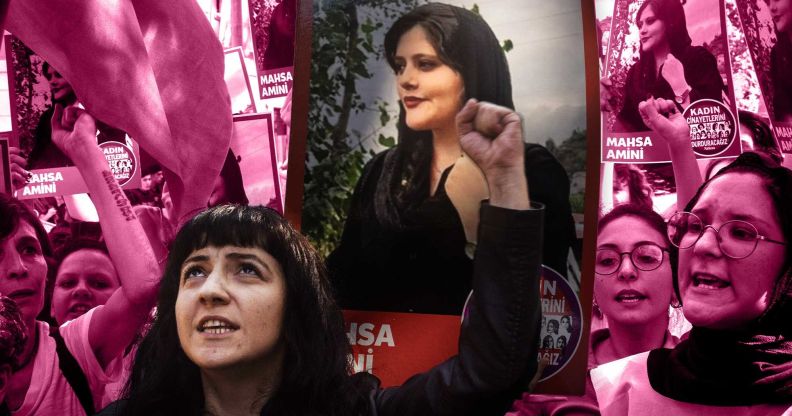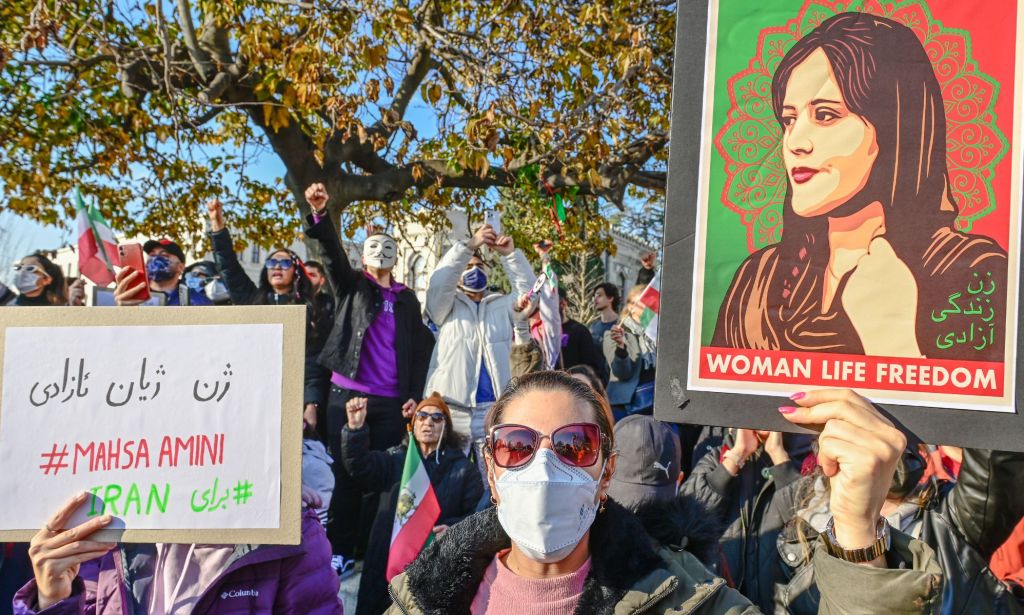‘She could be my sister’: Iranian activists on why Mahsa Amini protests are an LGBTQ+ fight too

Mahsa Amini’s death on 16 September 2022 became a rally call for thousands of Iranians to fight for the rights of women, LGBTQ+ folks and other marginalised groups. (Getty)
One year ago, Iran’s “morality police” detained and beat 22-year old Mahsa Amini for allegedly not wearing a headscarf properly. Her death led to the largest wave of popular unrest in years.
Amini, a young Iranian-Kurdish woman, died on 16 September 2022 after being beaten by authorities just three days earlier for allegedly violating Iran’s strict dress code for women by wearing an ‘improper head covering’.
The queer voices of Iran were at the forefront of protests as LGBTQ+ couples bravely kissed in public, held up rainbow flags and joined crowds to wave placards reading “Queer, Life, Freedom”.
The uprising wasn’t an isolated event. It was part of a long history of Iranian people struggling for their rights and dignity, especially women, LGBTQ+ people and other marginalised groups.
Shadi Amin, the executive director of Germany-based Iranian LGBTQ+ network 6rang (Iranian Lesbian and Transgender Network), grew up in Iran thinking she was “sick” because she’s queer.
It’s been “painful” to endure the hatred for her activism and being vocal, but she believes she could “continue for more than 25 years” fighting for Iran’s LGBTQ+ community.
So seeing the Mahsa Amini uprising last year was “really interesting” for Amin because it was looking at the “fruits” of other activists’ work in the “last 10-12 years” to highlight the shared struggles of LGBTQ+ people, women, ethnic minorities and other marginalised groups under the Islamic Republic of Iran’s oppressive regime.
“[LGBTQ+ people] are one of the most active and involved groups in these demonstrations and protests last year … We saw everywhere when there was a demonstration [there was] the rainbow flag, even if sometimes the people didn’t agree with that and they said go back,” Amin tells PinkNews.
“They tried to put us out of the demonstration, but I think our LGBTI youth community is really powerful and they try to bring their demands in this movement.”

Straight and LGBTQ+ people risked execution for their vision of a post-Islamic Republic Iran
Over 22,000 people were arrested and hundreds killed, including some who were executed by the state attempting to crush dissent through violence.
But the flames of freedom refused to die down. Oscar-winning actors, political leaders and women and girls worldwide publicly cut their hair to protest Amini’s death.
A report by 6Rang, based on research and testimonies of 70 LGBTQ+ people who participated in the protests, unveiled horrific accounts of persecution and harassment based on the sexual orientation and gender identity of protestors.
Queer protestors suffered extreme violence, verbal harassment, prosecution by authorities and sexual and physical abuse.
Iran criminalises same-sex sexual activity with a maximum punishment of death, and the law is actively enforced. LGBTQ+ people are subject to violence, discrimination, social rejection, arrest and harassment.
Amin doesn’t want young queer people to have the “same experience” she did. She knows they “deserve a better life”.
They say young people, regardless of their sexuality or gender identity, are killed in Iran “because they want freedom”.
So it’s important to recognise that the ‘Woman, Life, Freedom’ movement – the slogan that has its roots in the Kurdish women’s freedom movement and became a rallying cry during the Iranian protests in response to Mahsa Amini’s death – also includes LGBTQ+ people.
“So long as we have a group of people – it doesn’t matter if they are five, they’re 500, they’re 5,000 or five million, which I think there are more than eight million in Iran – who are challenging their gender identity and sexual orientation, including their families,” Amin says.
“In Iran, it [being LGBTQ+] is hidden. They cannot come out in public. So that’s why a lot of people say it’s not the time for that, and the government uses this argument and says the ‘Women, Life, Freedom’ movement is a movement for freedom of homosexuality and immorality.
“They try to use the taboos in society to make their hate propaganda against the movement and against the LGBT people.
“I think exactly now is the time that we say, ‘We have learned a lot from the last revolution, the past revolutions, and we don’t want to repeat it and this time for LGBT.’”
Mahsa Amini ‘could be my sister’
Arsham Parsi, who is the founder and executive director at the International Railroad for Queer Refugees, says Amini’s death struck a chord with so many people because she represented so many intersections of society.
“Every day, people are being arrested and killed,” Parsi says.
“Sometimes it could be, ‘Oh, have you heard about that person? Oh, it’s sad.’ Because when you see something over and over, it becomes normal for you.
“In the last several years, we have had more social movements, and people were trying to speak out.
“Mahsa Amini was kind of a slap in the face to a lot of people, and they said enough is enough.
“It was very important to LGBT rights as the LGBT movement – we have different movements in Iran, and Mahsa Amini, a lot of people identified with it.
“It makes a nationwide movement because of a couple of reasons. Mahsa Amini had several things at the same time.
“She was Kurdish-Iranian so she was part of a minority. So she could get [the] backing of a lot of minorities … She was a woman, and a lot of women’s movements tried to support it.
“She was young. She was different. She was not religious.
“So a lot of people identified that she could be my sister, she could be my daughter, she could be my cousin.”

Parsi, who fled Iran in exile and now lives in Canada, says it’s crucial that people continue to talk about the movement in Iran and “keep things alive for LGBT rights” because silence hides “every single inhuman action”.
“We need these alarms that [highlight] what’s going on, what’s happening,” he says.
“We have to keep it alive. If we let it go, the regime lets it go, the media lets go and it’s gonna be a dead issue.”
The LGBTQ+ Iranian activist explains that people worldwide can “offer their help” by doing small things, using their abilities and donating their time to raise awareness on the situation in the Middle Eastern country.
Parsi says it could be as easy as changing the design on a campaign website if someone works as a computer designer, talking to LGBTQ+ refugees if someone has a background in psychology or posting reputable information about what’s happening in Iran on social media to keep it in the news.
How did this story make you feel?

